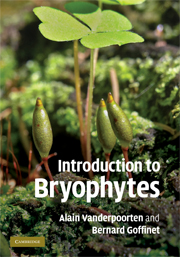8 - Physiological ecology
Published online by Cambridge University Press: 05 June 2012
Summary
The correlations between species distribution patterns and environmental factors that were analyzed in the previous chapters at different spatial scales are a vital starting point in making hypotheses about causes and effects of biotic interactions, historical factors, reproductive characteristics and immediate physiological requirements. It appears that most bryophyte species tend to occupy well-defined niches, as if they had evolved discrete physiological optima for factors such as humidity, light, temperature and nature of the substratum. Water availability, in particular, seems to play a major role in bryophyte distributions. In fact, bryophytes are believed to have colonized the land from a fresh water origin (Mishler & Churchill 1985). This major ecological shift must have required the evolution of adaptive mechanisms to survive such harsh drying treatments in order to have successfully exploited terrestrial habitats (Oliver et al. 2005).
In the present chapter, we describe adaptive strategies to drought and show how water relations interact with other physiological attributes and constraints to shape the ecological and geographical distribution of bryophytes.
Water relations
Adaptive strategies to drought
All the basic metabolic processes of life take place only in the aqueous medium of a hydrated protoplasm. Drying to equilibrium with even moderately dry air is, hence, instantly lethal to most animals and plants.
- Type
- Chapter
- Information
- Introduction to Bryophytes , pp. 185 - 213Publisher: Cambridge University PressPrint publication year: 2009
- 5
- Cited by



